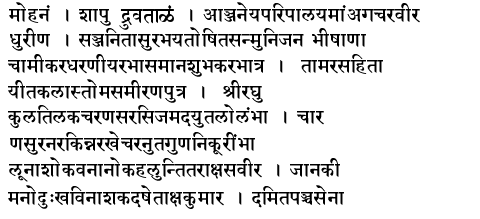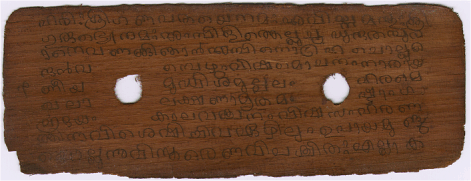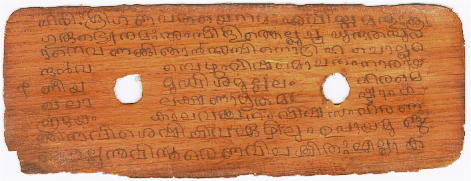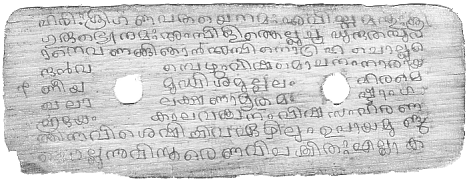
Writing on the manuscripts almost always was continuous without any delimiters or separators between words. Reading the manuscript will therefore require training as well as understanding of the language so that the lines may be split into words for easy reading by others. Splitting the text properly requires linguistic skills and cannot be easily automated through text processing programs.{Paragraph on traditional methods of presentations through copying. Accompanying errors.}
Manuscript preservation using computers
As of today, Information Technology has given us many tools which may be used for the preservation and storage of information. It is a viable proposition today to scan the leaves of a manuscript using a high resolution scanner and to store the image for subsequent study. Though an image of a typical leaf form of manuscript may occupy a Megabyte or more when scanned in colour at 600dpi, technology allows us to store a few manuscripts in this form on a CD-ROM that provides about 600 Megabytes of storage. This approach is certainly economical compared to the microfilming process where in spite of good image quality one encounters the problem of retrieval.
It remains to be seen as to whether the CD-ROM technology indeed allows reliable storage. In recent times questions have been raised about the longevity of the data in electronic form. We may assume however that though the technology may get updated, old information can get copied into the new media fairly easily.
Process of preserving manuscripts.
Modern Image processing techniques may be very effectively used in preserving the information contained in Palm leaf manuscripts. These methods are superior to the methods which use direct photographic techniques to capture the image of the leaf on film through high resolution cameras or Microfilming equipment. Even very fragile leaves may be kept between two sheets of transparent foils and scanned using a reasonably good resolution scanner, typically at 600 dpi. A good rule of thumb to apply is "if you can visually make out the writing, then the scanning process will always help". In the olden days, a black mixture was applied to the leaves after the text was written and this enhanced the readability of the text. Today, most of the surviving manuscripts have writing that is visible to the naked eye though it may be difficult to read the text if the leaf had turned dark, as in the illustration shown below. Here are some guidelines for getting a good image of a leaf.
1. Use a high resolution scanner (typically 600 dpi) to scan the leaf. If the leaf is very fragile, then retain it between two transparencies ( the type used for overhead projectors). Leaves shorter than eight inches may be scanned by arranging them one below the other to fill the scan area. Longer leaves will have to be placed lengthwise and rotated subsequently using the image processing program. It always helps to let the scanning utility know that the image should be scanned as a colour image with millions of colours. Scanning utilities may allow the image to be treated as sharp colour photographs but this may sometimes result in slight loss of quality.
2. Use an image enhancement program such as Adobe Photo shop or Corel Photo paint. Most leaves may give good images after a bit of brightness and contrast enhancement is effected. For dark leaves, it may be helpful to split the colour images into CMYK and one of the resulting images will almost always be legible. This legible image may also be enhanced subsequently as it will be a black and white image.
Shown below is a section of a leaf (about 200 years old) with poor contrast. The cyan image after the image split operation turned out to quite clear and with a bit of tone adjustment resulted in the image that follows the colour image.

Here is another example of processing that may be of interest to the viewer. This example relates to a manuscript in Malayalam that is also about two hundred years old. The manuscript is titled " Visha Vaidyam" which relates to the treatment for poisons. The manuscript is physically about five inches by two inches (5x2 inches). The leaf seen has been scanned and the image created at 96 dpi resolution.It is observed that the text in the image as scanned, is hardly visible
.

The above image, when enhanced by applying tone modifications (darker regions made lighter) is lot easier to read but has changed colour.

In the third step, when the image above is split into CMYK, i.e., separated into cyan, magenta, yellow and Black, the image is clearly visible and one can read the text.

What has been shown is not necessarily the best approach but one that works in practice. Each manuscript will have to be examined for the best enhancement that can be attempted.Some interesting statistics relating to palm leaf manuscripts (This section not completed yet!)
1. size 2. Number of leaves 3. Leaf numbering scheme 4. Colophons 5. Manuscripts typing methods
Interesting problems. Absence of dots and other punctuation marks

